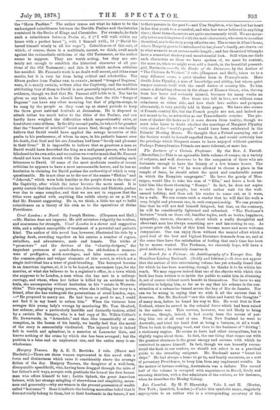Margery Travers. By A. E. N. Bewicke. 3 vole. (Hurst
and Blackett.)—There are three women represented in this novel with a force and distinctness which raise it considerably above the average fiction of the day. Margery Travers, the daughter of a well-born, disreputable spendthrift, who, having been dragged through the mire of her father's evil ways, accepts with gratitude the love of the first honest man who offers himself to her ; Lottie Spluck, the great American heiress, with her strange mingling of shrewdness and simplicity, mean- ness and generosity—why are women in the present possession of wealth called "heiresses"? Does it indicate the lurking masculine belief that it does not really belong to them, but to their husbands in the future, if not
to their parents in the past 7—and (Ina Stapleton, who has lost her heart in her first youth to a scoundrel, and who has never believed in anything since ; these three cheracters are quite uncommonly vivid. Wo are natur- ally not so much impressed v. ith the male characters, who seem to us rather theatrical, nor is the story a very effective ono. The scones in Allan's home, where Margery goes to be introduced to her fiances family,aro drawn out to what seems to us an unreasonable length ; and her theatrical triumphs have a somewhat shadowy and unsubstantial look. Still when one finds such characters as those we have spoken of, we must be content, the more so, when we might even add a fourth, in the beautiful peasant- girl, 3lariuccia.—Q,, the Banks of the Delaware, by the Author of "The Château de Ve'sinet," 2 vols. (Chapman and Hall), takes us to a very different scene, a quiet Quaker farm in Pennsylvania. Here dwells John Plymley, a man of knowledge and ability, but whose quiet temper contents itself with the small duties of country life. To him comes a disturbing element in the shape of Eleanor Grant, who, thrown from her horse and seriously injured, becomes for many weeks an inmate of the farm. How these two fall in love, not without some reluctance on either side, and how their love suffers and prospers alternately, is very prettily told in these pages. We have also scenes of French country life, but the French people are not, and indeed are not meant to be, as attractive as our Transatlantic cousins. Tho pic- ture of Quaker life looks as if it were drawn from reality, though we must take leave to doubt whether the marriage of Margaret Plymloy with one of tho " world's people " would have been celebrated in the Friends' Meeting House. We thought that a Friend marrying out of the Society would be herself expelled from it, and would certainly lose the privilege which Margaret seems to have enjoyed without question Perhaps Pennsylvanian Friends are more tolerant, or more lax.


































 Previous page
Previous page